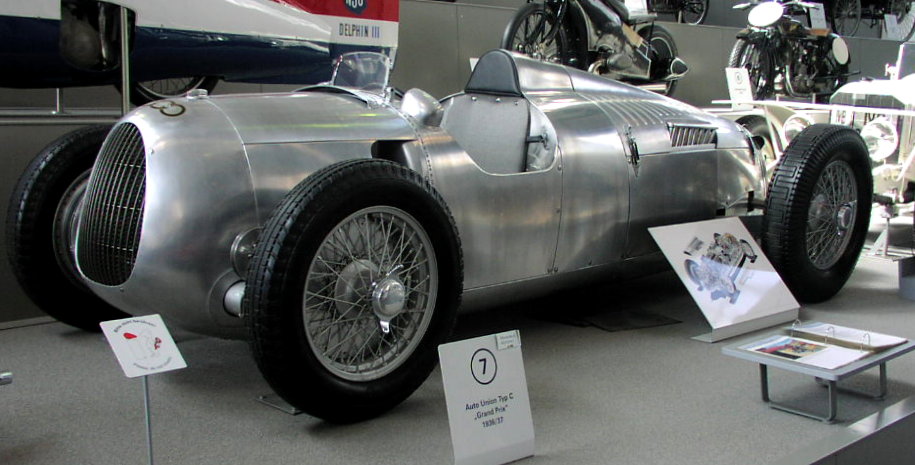1937 Auto Union Typ C

The descriptions of the Classic Cars in the Directory were partly generated or supplemented with the help of artificial intelligence (AI). The content may occasionally not always be entirely accurate or factually correct despite careful checking.
The Auto Union Typ C 1937 was a groundbreaking race car that took the motor racing world by storm. The vehicle was engineered by Auto Union, a German car manufacturing company, during the era of pre-World War II motorsports. It was created to compete with the dominant Mercedes-Benz vehicles and establish the Auto Union brand as a formidable force in Grand Prix racing.
The Auto Union Typ C 1937 boasted several technical details that made it a remarkable machine. From its aerodynamic design to its powertrain, the vehicle was crafted to achieve maximum speed and agility on the track. Here are some of the most notable technical details of the Typ C:
Chassis and Suspension:
The Typ C featured a tubular framework that was lightweight yet robust. It was designed to handle the high speeds and stresses encountered on the racetrack. The suspension system comprised a Double Wishbone Suspension, which was an innovative design for the time. It utilized two unequal length wishbones for each wheel, resulting in a more stable ride and better handling.
Engine:
The Typ C was powered by a mid-mounted V16 engine, which was a technological marvel at the time. The engine was capable of producing 485 horsepower and could reach speeds of up to 350 kilometers per hour. The V16 engine's unique configuration was a feature that set the Typ C apart from its competitors. The engine's structure allowed the car to achieve an excellent weight balance, making it more responsive and increasing its cornering speed.
Transmission:
The Typ C was equipped with a 4-speed manual transmission system that delivered the engine's power to the rear wheels. This system was designed to cope with the engine's significant torque, which allowed the car to accelerate rapidly and reach high speeds in a short period.
Brakes:
The vehicle's braking system was another advanced feature. The Typ C 1937 utilized hydraulic brakes, which were a novelty at the time. The front wheels featured hydraulic drum brakes, while the rear had hydraulic twin-cylinder brakes. The braking system gave the driver greater control over the car, making it easier to handle and decreasing its stopping distance.
Aerodynamics:
The Typ C was aerodynamically designed to reduce drag and increase downforce. The vehicle's streamlined bodywork made it more efficient at high speeds, allowing the car to maintain its pace while reducing wind resistance. The vehicle's low nose and long tail design allowed it to create significant amounts of downforce, which enhanced its cornering and handling abilities.
In conclusion, the Auto Union Typ C 1937 was an exceptionally engineered race car that owed its success to its advanced technical features. The vehicle's engine, transmission, suspension, and braking systems were all designed to maximize its performance on the racetrack. Its aerodynamic design and innovative chassis made it a unique machine that still fascinates car enthusiasts to this day. The Auto Union Typ C remains an iconic vehicle that revolutionized motorsports and set a new standard for race car engineering.
Milestones
- Auto Union Typ C designed by Ferdinand Porsche in 1936 - Officially unveiled at the International Automobile and Motorcycle Exhibition in Berlin in February 1937 - Powered by a supercharged V16 engine, producing 520 horsepower, making it one of the most powerful cars of its time - Race debut at the 1937 Eifelrennen at the Nürburgring, with legendary driver Bernd Rosemeyer behind the wheel - Typ C dominates the Grand Prix season of 1937, winning four of six races - Rosemeyer wins the Vanderbilt Cup in Long Island, New York, becoming the first non-American driver to win the event - Typ C breaks the 400 km/h barrier on the Dessau Autobahn in January 1938, with Rosemeyer at the wheel - Auto Union withdraws from Grand Prix racing in 1939 with the outbreak of World War II, ending the Typ C's racing career - Several Typ C models survive to this day and are highly coveted by collectors for their historical significance and innovative engineering.Technical
• Engine: 6-cylinder supercharged engine with a displacement of 4,956 cc.• Power output: 545 horsepower at 5,500 rpm and a top speed of 340 km/h (211 mph).
• Drive system: Rear-wheel drive with a four-speed manual transmission.
• Suspension: Independent suspension with coil springs, telescopic shock absorbers, and double wishbones.
• Brakes: Hydraulic drum brakes fitted to all wheels.
• Body: Streamlined aluminum and magnesium body with a total weight of 800 kg (1,764 lb).
• Aerodynamics: A coefficient of drag of 0.25, with a drag area of 0.6 m².
• Steering: Rack and pinion steering system.
• Fuel system: Three Solex carburetors and a fuel tank capacity of 120 liters.
• Tires: 5.50-19 front and 7.00-19 rear Dunlop racing tires.
SUPERMIND TRIVIA
